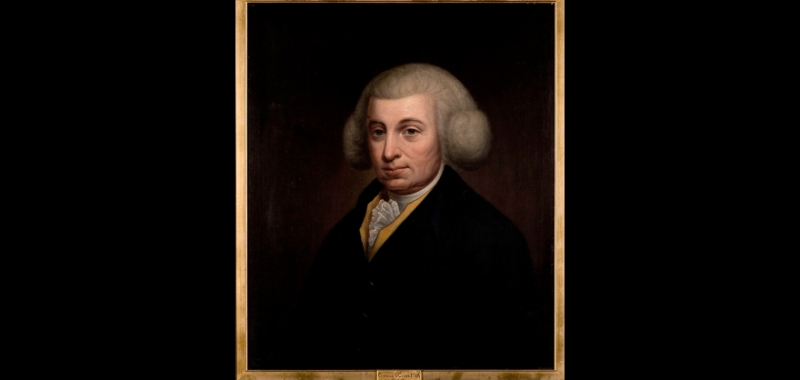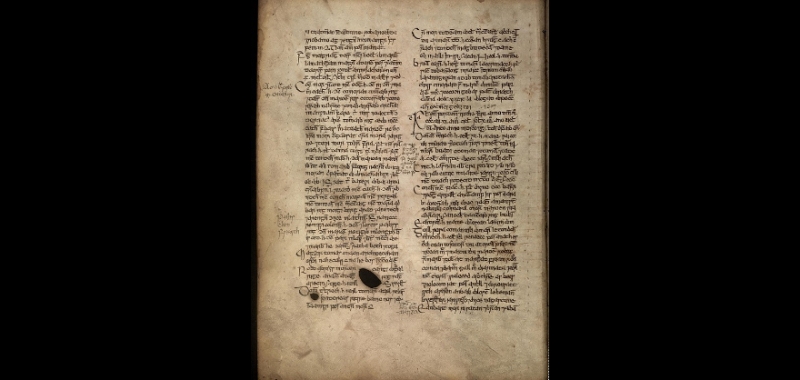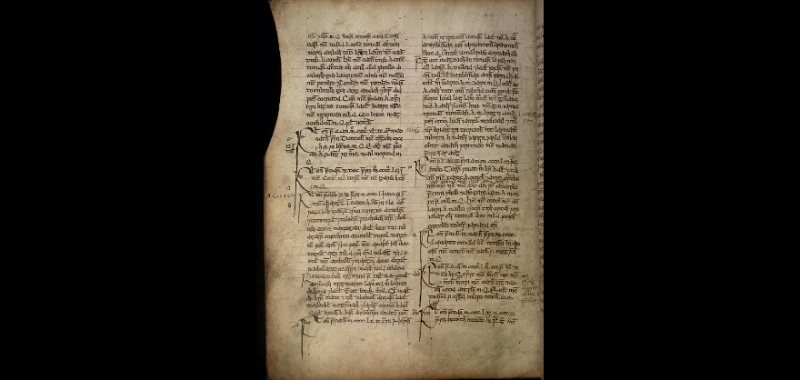Annals of Connacht
RIA MS C iii 1 (Cat. No. 1219). 16th century. Vellum: 29cm x 21cm. [91] folios
This unique manuscript records episodes in the history of Gaelic Ireland for over three hundred years from AD 1224 to AD 1544, with one later entry added (in different ink) for the year 1562. There are short gaps in the text, from 1378 to 1384 and from 1393 to 1398, where it appears that a pair of leaves has been lost. There is another gap from 1427 to 1432, but without evidence of loss of a text. In this latter case, perhaps there was a leaf missing from the older exemplar being used by the scribe, and no alternative source was available from which entries for those years could be derived.
This manuscript was referred to as ‘Connacht’ annals by Charles O’Conor (d.1791) in his correspondence in 1767, and the same title was used in 1818 when it was catalogued by his grandson, Revd Charles O’Conor, as part of the Stowe library collection. In reality, the compilation does not concentrate on events in the province of Connacht after the mid-fourteenth century.
Some of the contents of the Annals of Connacht are very similar to entries in the Annals of Loch Cé, which were penned in the 1580s (TCD, MS 1293 and British Library, Additional MS 4792) and are primarily associated with the learned family of Ó Duibhgeannáin who were based at Kilronan, County Roscommon and nearby Castlefore, County Leitrim. The similarity in content is particularly evident for the years 1014 to 1316 and again from 1479 to 1544. It is likely that the compilers of the Loch Cé annals and the Connacht annals drew on a common source for those years.
Contents
Compiling entries for each individual year and arranging them in chronological sequence by year is the oldest form of historical writing. It is relatively easy to organise material in this way; and relatively easy to consult annals to find information on specific events. This simplicity of structure is the main reason for the continued popularity of annals through the middle ages and beyond.
The Annals of Connacht open with a long obituary for Cathal Crobderg O’Conor (d.1224), and obituaries of other prominent persons dominate the first half of the text. Although there is an emphasis on the O’Conors of Connacht, these annals fall well short of comprising a narrative history of that family. Martin Freeman pointed out that it would be ‘impossible to follow the succession of the various families of O’Connor and Burke without supplementing the information afforded by this text from the other Annals’ (Freeman, p. vii). Incidental astronomical data is also included.
A characteristic feature of these, as of other late medieval annals, is that obituaries and accounts of battles and other exploits are recorded as discrete events, without any causal connections between them. Events are not usually arranged in chronological order within each year; the structure is more haphazard than that. While these annals can seem like nothing more than an accumulation of disjointed historical data, each event was recorded for a reason. When taken together, the compilation is a valuable record of significant persons and events within the Gaelic world of medieval Ireland.
The repeated preparation of new sets of annals, each partly derivative of older works, is evidence of the lasting value attached to the annalistic format as a flexible system for recording significant events in an accessible way that had the appearance of being objective (Mac Niocaill, 1975; Patterson, 1994, vii–ix).
The contents of these annals are symbolic of the power still felt to be held by the leading Gaelic families. They are not a coherent political narrative, but a miscellany of individual episodes that reflect the de-centralised nature of political power in late medieval Gaelic lordship society. The values and attitudes they unwittingly portray are those of the political world of the network of Gaelic lordships of the western and northern parts of Ireland, in the era before the so-called ‘Tudor conquest’ of Ireland in the sixteenth century. They are a clear voice of a confident and self-assured native community prior to the initiation of a new era of colonisation. As such, the myriad details from that world that were selected for memorialisation by professional historians from within those communities are one of the most important keys we have that can unlock the secrets of that elusive past.
Scribes
The manuscript in which the Annals of Connacht are preserved (RIA, MS C iii 1) was written in Irish in the early sixteenth century by three principal scribes whose surnames are not recorded. The writing, on vellum, is laid out in double columns with generous margins, but without decorative capitals.
The first scribe was ‘Paitín’ whose name is on folio 17 and who penned the first 61 folios, containing entries for the years 1224 to 1467. This scribe’s penmanship has been described by Martin Freeman as ‘classical, formal and of the medieval school’ (Freeman, xi). However, Freeman also noted that Paitín’s scholarship was nothing exceptional and that he was prone to make mistakes that he failed to correct appropriately.
A second, but unnamed, scribe wrote folios 62 to 66 and some occasional lines elsewhere, and his hand can also be described as traditional. His contribution ended with the year 1478. The first two scribes of our manuscript may have had a comprehensive set of older annals to work from, and the second of our scribes may have stopped work here on folio 66 when the exemplar he was using came to an end, at the year 1478.
The third main scribe of our manuscript was Iohannes (Seán) R[iabha]ch whose name is on the verso of folio 66. He wrote most of the remainder of the manuscript from folio 66 to folio 90. Seán Riabhach’s hand was described by Freeman as being ‘an open square upright hand of an altogether different type, introducing a thoroughly modern atmosphere’ (Freeman, p. xii). When Seán Riabhach annotated the manuscript, he mentioned his regret that another person named ‘Dolp’ was not present. This suggests that a person named Dolp had been involved, though in what capacity is unclear.
There may have been a significant lapse of time between the writing of the earlier sections and the commencement of work by Seán Riabhach. There are notable differences in the text from 1479 onwards. The elaborate calendrical data that was a distinctive feature of the early part of the manuscript was no longer given at the beginning of each year. Instead, only the AD (anno domini) date was given. The third scribe was also inclined to leave blank space under various annual headings as though hoping to discover further material to insert under a given year. This may indicate that he no longer had access to a comprehensive set of annals as an exemplar but was piecing together material from more scattered sources.
Kathleen Mulchrone considered that the scribes were probably members of the learned family of Ó Duibhgeannáin, a view supported by Paul Walsh (1947, 23–4) and more recently by Daniel Mc Carthy (2008, 45–6). Martin Freeman’s suggestion that they might have been members of the Ó Maoil Chonaire family is no longer thought to be correct.
Although the manuscript is believed to be the work of scribes from the Ó Duibhgeannáin family, the Annals of Connacht are thought to derive from an older source that was the work of the learned family of Ó Maoil Chonaire, hereditary historians to the O’Conors of Connacht (Mac Niocaill, 1975; Mc Carthy, 2008, 270).
Chronological apparatus
Daniel Mc Carthy, in his major study of Irish annals, has shown that in terms of the system of recording calendar dates the Annals of Connacht contain the most comprehensive chronological apparatus of any Irish annalistic text (Mc Carthy, 2008, 46). This mastery of complex chronological data particularly by the first of the three scribes (or his source) is one indication of the scholarly sophistication of the earlier professional historians from whose work the Annals of Connacht are derived (Mc Carthy, 2008, 270). That feature is not carried through to the end of the manuscript, however, with the third scribe, Seán Riabhach, showing less interest is such matters when compiling entries for the years 1479 to 1544.
Provenance
In the eighteenth century the manuscript was in the possession of the Ó Duibhgeannáin family. It seems likely that it had remained with that family since it was first compiled. A note including the name ‘Domnick Diggenan’ was added in 1727 (fol. 15r). By 1744 the manuscript had come into the possession of Charles O’Conor of Belanagare, Co. Roscommon, who began to add his own annotations in the margins. He appears to have retained it to the end of his life. It was subsequently acquired by the Duke of Buckingham, who employed Charles O’Conor’s grandson as his librarian and acquired many of the older Irish manuscripts of Connacht provenance that the older O’Conor had collected. It was sold to the Earl of Ashburnham in 1849 and was among the ‘Stowe/Ashburnham’ manuscripts of Irish interest presented by the British Government to the Royal Irish Academy in 1883.
Binding
The penultimate binding dated from 1794. It was in calf, blind-tooled and with gilt lettering on the spine: ‘Irish Ms. No. IX Ann. Connac. Saec. XVI’. Inside the old front cover was a label ‘Stowe MS (Ashburnham Collection), Press 1, No. 9’ and inside the back cover was a book plate of a former owner ‘Charles O’Connor of Belanagare, 1753’. In 2008–9, the manuscript was disbound and earlier repairs removed by Anthony Cains. The Annals were repaired, conserved and rebound in quarter–cut Irish oak boards, covered in alum-tawed calf. They were placed in a buckram-covered millboard drop-back box, custom-made by Anthony Cains; the box includes a drawer in the base which holds the eighteenth-century boards. The binding was funded ex Library funds and with a very generous donation from Dr B. Cunningham, Deputy Librarian. The ancillary historical papers which had been loosely bound in were separated from the Annals, repaired, conserved, bound in a leather guard-book and placed in a slip case by Mrs Elaine Cains. The ancillary papers (23 unnumbered pages) date from the seventeenth and eighteenth centuries and are mostly genealogical in nature, principally relating to the O’Conor and MacDermot families.
Published edition
A full edition of the Annals of Connacht, with English translation, was published in 1944, and reprinted by the Dublin Institute for Advanced Studies in 1970. A searchable transcript of the Irish text, together with an English translation, based on Martin Freeman’s edition (1944), is available on the Celt website. Digital images of each page of the main manuscript can be viewed on Irish Script on Screen.
Further reading
- Cunningham, Bernadette, ‘Annals and other histories of Ireland’ in B. Cunningham and S. Fitzpatrick (eds), Treasures of the Royal Irish Academy Library (Dublin, 2009), 71–8
- Cunningham, Bernadette, The Annals of the Four Masters: Irish history, kingship and society in the early seventeenth century (Dublin, 2010)
- Cunningham, B. & Fitzpatrick, S., Aon amharc ar Éirinn: Gaelic families and their manuscripts (Dublin, 2013), 12–14
- Cunningham, Bernadette, ‘Conserving the Annals of Connacht’, in George Cunningham (ed.), 60 at Roscrea: celebrating the Roscrea Conference at Mt St Joseph Abbey, 1987–2017 (Roscrea, 2017), 122–4
- Finan, Thomas, ‘O’Conor “grand strategy” and the Connacht chronicle in the thirteenth century, in Thomas Finan (ed.), Medieval Lough Cé: history, archaeology and landscape (Dublin, 2010), 158–80
- Freeman, A. Martin (ed.), Annála Connacht / the Annals of Connacht A.D. 1224–1544 (Dublin, 1944, 1970)
- Gwynn, Aubrey, ‘The Annals of Connacht and the Abbey of Cong’, Journal of the Galway Archaeological and Historical Society, 28 (1956–7), 1–9
- Mc Carthy, Daniel P. The Irish annals: their genesis, evolution and history / Daniel P. McCarthy (Dublin, 2008)
- Mac Niocaill, Gearóid, The medieval Irish annals (Dublin, 1975)
- Mulchrone, Kathleen, ‘C iii 1’, in Catalogue of Irish manuscripts in the Royal Irish Academy (Dublin, 1943), Fasc. 26: 3274–82
- Ó Corráin, Donnchadh, ‘Irish annals: transmission & criticism’, in Donnchadh Ó Corráin, Clavis Litterarum Hibernensium, II (Turnhout, 2017), item 699
- Ó Corráin, Donnchadh, ‘Annals of Connacht al. Annála Connacht’, in Donnchadh Ó Corráin, Clavis Litterarum Hibernensium, II (Turnhout, 2017), item 712
- O’Dwyer, B. W., ‘The annals of Connacht and Loch Cé and the monasteries of Boyle and Holy Trinity’, Proceedings of the Royal Irish Academy, 72 C (1972), 83–101 (jstor.org)
- Ó Murchadha, Diarmuid, ‘A reconsideration of some place-names from ‘The annals of Connacht’, Ainm (Ulster Place-Name Society), 6 (1994–5), 1–31
- Patterson, Annabel, Reading Holinshed’s Chronicles (Chicago, 1994)
- Walsh, Paul, ‘The books of the O Duigenans’, in Colm Ó Lochlainn (ed.), Irish men of learning: studies by Father Paul Walsh (Dublin, 1947), 13–24.
- www.isos.dias.ie
- www.ucc.ie/celt
BC
updated 2020



